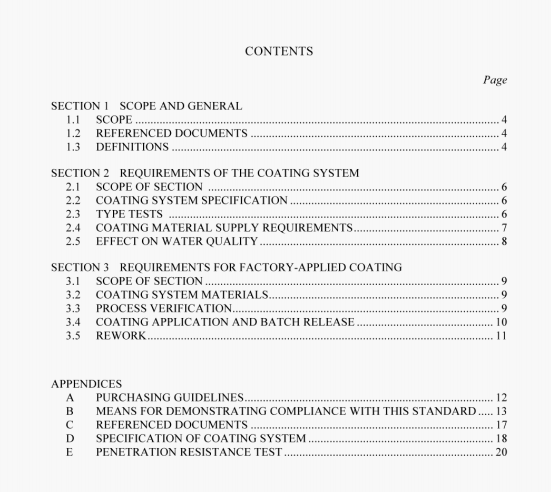AS/NZS 4158:2003 pdf – Thermal-bonded polymeric coatings on valves and fittings for water industry purposes.
2.3.6 Penetration resistance
Then tested in accordance with Appendix F. the penetration shall he less than or equal to 10% of the specified minimum coating thickness. This test is not required for epoxy materials.
2.3.7 Abrasion resistance
The abrasion resistance test shall be in accordance with ASTM [)406() with CS17 wheel. 1000 g load for 1000 cycles at 23 ±2°. The weight loss shall be less than or equal to 40 mg.
2.3.8 Cathodic disbondment
The test shall be carried out either in accordance with AS/NZS 4352. using Test Cell A or
B. at 23 ±2°C for 28 days, or in accordance with BS 3900 Part Fl lat 23 ±2°C for 28 days.
The average radial disbonded length shall be less than or equal to 15 mm.
2.3.9 Thermal stability
2.3.9.1 Tbermo.ceiiing materials
Three coated panels shall be prepared and tested in accordance with AS 3862. flexibility test, at 1% strain and at ambient temperature. The panels shall then be exposed in air at 100 ±2°C for 100 days. There shall be no holidays in the tension face of the coated samples after the exposure period when holiday tested to AS 3894,1 at 2400 V.
2.3.9.2 Thermoplastic materials
Six films of coating shall be prepared by application onto silicone-release-coated, or Tetlon-coated steel panels, or by application onto other suitable panels. The films shall he produced by coating application at the maximum allowable application temperature. The thickness of the films shall be in the range 250 to 500 jim. Three of the films shall be exposed in air at 100 ±2°C for 100 days. Either melt flow rate (to ISO 1133) or elongation at break (to AS 1145.3) shall be measured on the films both prior to and after exposure. The average of the three results on the exposed films shall not vary by more than 35% for melt flow rate, or 50% for elongation at break, from the average of the three results on the unexposed films.
NOTE: The film may be removed from the substrate before or after exposure.
2.3.10 Ultraviolet radiation
The coating shall be tested in accordance with ASTM D2565, Type B. for 100 days. The coating preparation and test requirements shall be in accordance with Clauses 2.3.9.1 and
2.3.9.2.
2.3.11 Repair Coating Material
The repair coating material shall be tested for adhesion to a metal substrate and water absorption, as follows:
(a) The repair coating material shall be applied in accordance with Appendix D to a flat plate. After any required curing period, the repair shall be tested for adhesion in accordance with AS 1580,408.2. The adhesion rating shall be less than or equal to 2.
(b) The repair coating material shall be tested in accordance with Clause 2.3.3 for water absorption. The amount of water absorption shall be less thaii or equal to 5.0%.
2.4 COATING MATERIAL SUPPLY REQUIREMENTS
The coating material shall be tested to demonstrate/ensure consistency. A certificate of compliance (from the coating material manufacturer), stating that the coating material meets the manufacturer’s required internal batch release testing (to demonstrate consistency) shall be deemed sufficient evidence of the suitability of the coating material.
AS/NZS 4158:2003 pdf – Thermal-bonded polymeric coatings on valves and fittings for water industry purposes
